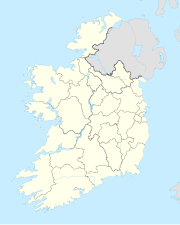
A passage grave or passage tomb consists of one or more burial chambers covered in earth or with stone, and having a narrow access passage made of large stones. These structures usually date from the Neolithic Age, and are found largely in Western Europe. When covered in earth, a passage grave is a type of burial mound which are found in various forms all over the world. When a passage grave is covered in stone, it is a type of cairn.

Newgrange is a prehistoric monument in County Meath in Ireland, located on a rise overlooking the River Boyne, 8 kilometres (5.0 mi) west of Drogheda. It is an exceptionally grand passage tomb built during the Neolithic, around 3200 BC, making it older than Stonehenge and the Egyptian pyramids. It is aligned on the winter solstice sunrise. Newgrange is the main monument in the Brú na Bóinne complex, a World Heritage Site that also includes the passage tombs of Knowth and Dowth, as well as other henges, burial mounds and standing stones.
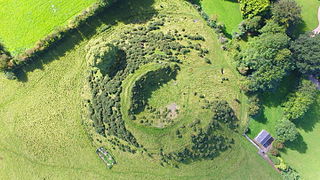
Dowth is a Neolithic passage tomb located in the Boyne Valley, County Meath, Ireland. It is one of the three principal tombs of the Brú na Bóinne World Heritage Site – a landscape of prehistoric monuments including the large passage-tombs of Dowth, Newgrange and Knowth. Unlike Newgrange and Knowth, Dowth has not been independently dated, but its features align it with the other passage tombs which date from between approximately 3200 and 2900 BC. However, Harbison (1970) dates the tomb at 2500 – 2000 BC. It is less developed as a tourist attraction than its neighbours, partly because the chamber is much lower, and partly because the decoration is less visible. It was partly excavated, in 1847 by the Royal Irish Academy who dynamited the roof causing the still visible crater, though it was pillaged by Vikings and earlier looters long before that.. Archaeological and geophysical field surveys of the entire site, including later monuments, were carried out episodically from 2012-2015. In July 2018, another passage tomb in the grounds of nearby Dowth Hall was excavated, revealing significant examples of Neolithic rock art similar to those at Dowth and the other Brú na Bóinne sites.

Loughcrew or Lough Crew is an area of historical importance near Oldcastle, County Meath, Ireland. It is home to a group of ancient tombs from the 4th millennium BC, some decorated with rare megalithic art, which sit on top of a range of hills. The hills and tombs are together known as Slieve na Calliagh and are the highest point in Meath. It is one of the four main passage tomb cemeteries in Ireland and is a protected National Monument. The area is also home to the Loughcrew Estate, from which it is named.

Knowth is a Neolithic passage grave and an ancient monument of the World Heritage Site of Brú na Bóinne located 8.4 km west of Drogheda in Ireland's valley of the River Boyne. It is the largest passage grave of the Brú na Bóinne complex. It consists of a large mound and 17 smaller satellite tombs. The mound is about 12 metres (40 ft) high and 67 metres (220 ft) in diameter, covering roughly a hectare. It contains two passages placed along an east-west line and is encircled by 127 kerbstones, of which three are missing, and four badly damaged.

The Giant's Ring is a henge monument at Ballynahatty, near Shaw's Bridge, Belfast, Northern Ireland. It was originally preserved by Viscount Dungannon. The inscribed stone tablet on the wall surrounding the site which details Viscount Dungannon's interest was carved by Belfast stonecarver Charles A Thompson about c.1919.

Carrowmore is a large group of megalithic monuments on the Cúil Iorra Peninsula to the west of Sligo, Ireland. They were built in the 4th millennium BCE, during the Neolithic era. There are thirty surviving tombs, making Carrowmore one of the largest clusters of megalithic tombs in Ireland. It is considered one of the 'big four' along with Carrowkeel, Loughcrew and Brú na Bóinne. Carrowmore is the heart of an ancient ritual landscape which is dominated by the mountain of Knocknarea to the west. It is a protected National Monument.

Brú na Bóinne or Boyne valley tombs, is an area in County Meath, Ireland, located in a bend of the River Boyne. It contains one of the world's most important prehistoric landscapes dating from the Neolithic period, including the large Megalithic passage graves of Knowth, Newgrange and Dowth as well as some 90 additional monuments. The archaeological culture associated with these sites is called the "Boyne culture".
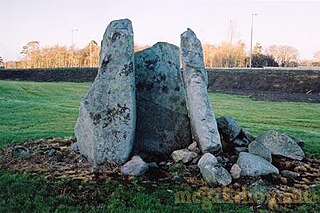
Brehon's Chair, sometimes Druid's Chair, is a megalithic site, and national monument, in Whitechurch, Rathfarnham, Dún Laoghaire-Rathdown, in the traditional County Dublin, Ireland.
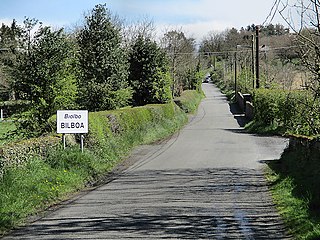
Bilboa is a settlement located on the boundaries of counties Carlow, Laois and Kilkenny in Ireland. A bridge, a short distance from the village and built c. 1800, is known as the 'Three Counties Bridge'.
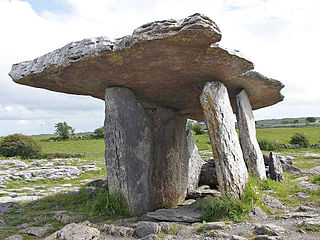
Megalithic monuments in Ireland typically represent one of several types of megalithic tombs: court cairns, passage tombs, portal tombs and wedge tombs. The remains of over 1,000 such megalithic tombs have been recorded around Ireland.
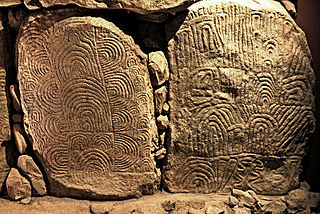
Gavrinis is a small island in the Gulf of Morbihan in Brittany, France. It contains the Gavrinis tomb, a megalithic monument notable for its abundance of megalithic art in the European Neolithic. Administratively, it is part of the commune of Larmor-Baden.
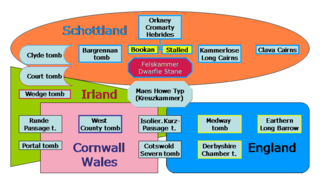
British megalith architecture is the study of those ancient cultures that built megalithic sites on the British Isles, including the research and documentation of these sites. The classification sometimes used of these cultures based on geological criteria is problematic.

Ahenny is a small village and townland in County Tipperary, Ireland. It is notable for its ancient Irish high crosses. Close to the village is the early Christian foundation of Kilclispeen monastery and in the adjoining graveyard stand two celebrated Irish High Crosses: the Ahenny High Crosses.
Patrick McKee is an Irish former politician. He is a member of Fianna Fáil, and was formerly a member of Renua and was their candidate in the 2015 Carlow-Kilkenny Dáil by-election.
Archaeo-optics, or archaeological optics, is the study of the experience and ritual use of light by ancient peoples. Archaeological optics is a branch of sensory archaeology, which explores human perceptions of the physical environment in the remote past, and is a sibling of archaeoastronomy, which deals with ancient observations of celestial bodies, and archaeological acoustics, which deals with applications of sound.

Rathcoran is a passage grave and hillfort and National Monument located atop Baltinglass Hill, County Wicklow, Ireland.

Fourknocks Passage Tomb is a passage grave and National Monument located in County Meath, Ireland.

Knockmany passage tomb, or Anya's Cove, is an ancient burial monument on the summit of Knockmany Hill, near the village of Augher in County Tyrone, Northern Ireland. It is the remains of a Neolithic passage tomb and its stones are decorated with rare megalithic art. They are protected by a concrete chamber and mound, built in 1959 by the Department of the Environment, roughly resembling the mound that would have originally covered it. The stones can be viewed through the entrance gates. It is a monument in state care.
Passage tombs are a category of Megalithic monument from the Neolithic period. They are found in most regions of Ireland but are more prevalent in the Northern half of the island. The usage period of Irish passage tombs date from c. 3750 B.C. to about 2500 B.C. About twenty clusters are recorded in Ireland, but the best known examples are found along a curved trajectory from the west coast to the east, including the centres of Carrowmore and Carrowkeel in County Sligo, and Loughcrew and the Boyne Valley in County Meath.

